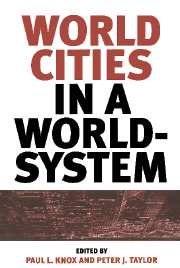Book contents
- Frontmatter
- Contents
- List of contributors
- Preface
- Part 1 Introduction: world city, hypothesis and context
- 1 World cities in a world-system
- 2 Where we stand: a decade of world city research
- 3 World cities and territorial states: the rise and fall of their mutuality
- 4 On concentration and centrality in the global city
- Part 2 Cities in systems
- Part 3 Politics and policy in world cities: theory and practice
- Appendix The world city hypothesis
- Index
2 - Where we stand: a decade of world city research
Published online by Cambridge University Press: 07 October 2009
- Frontmatter
- Contents
- List of contributors
- Preface
- Part 1 Introduction: world city, hypothesis and context
- 1 World cities in a world-system
- 2 Where we stand: a decade of world city research
- 3 World cities and territorial states: the rise and fall of their mutuality
- 4 On concentration and centrality in the global city
- Part 2 Cities in systems
- Part 3 Politics and policy in world cities: theory and practice
- Appendix The world city hypothesis
- Index
Summary
As an interlocking system of production and markets, the global economy is a discovery of the 1970s (Barnet and Müller 1974). At the time there was a good deal of controversy over the so-called ‘new international division of labour’ (Fröbel et al. 1980) and a centuries-old ‘world system’ (Wallerstein 1974). Research paradigms were being born.
The significance of these theoretical developments for the study of urbanization was not recognized until the early 1980s (Cohen 1981; Friedmann and Wolff 1982). Ten years have passed since then, and this chapter is an attempt to survey what we have learned and to assess where we stand in the study of world cities. I begin with a discussion of some conceptual issues: what is the ‘theoretical object’ of world cities research? How shall we define the elusive notion of world city? I then launch into an extended review of the literature, including theoretical developments in the 1980s and empirical studies in the early 1990s. The third section takes a closer look at the notion of a structured hierarchy of world cities and argues the need to remain ever alert to economic and political changes that may lead to the rise and fall of world cities that are linked to each other in ‘antagonistic co-operation’.
- Type
- Chapter
- Information
- World Cities in a World-System , pp. 21 - 47Publisher: Cambridge University PressPrint publication year: 1995
- 256
- Cited by

